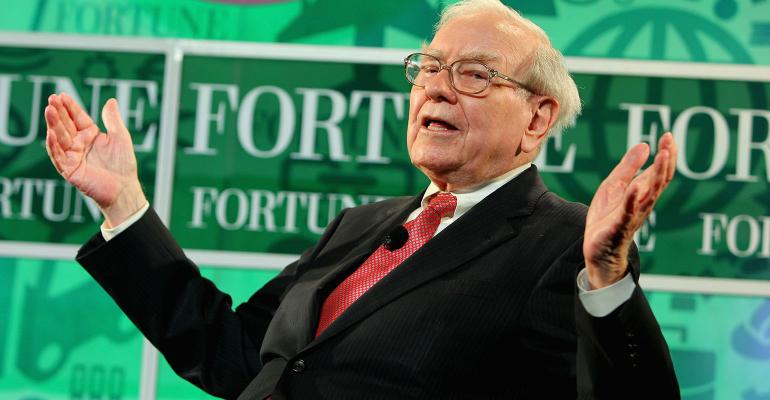Breaking news: Luncheon postponed; winner has kidney stones.
What’s the difference in the cost of a buffet lunch for eight people and a Buffett lunch for eight?
That extra “t” in Buffett is going to cost you.
Cryptocurrency billionaire Justin Sun recently paid $4.57 million in an online auction by Glide, a San Francisco charity that aids the city’s poor and homeless, for lunch with Warren Buffett and seven of the donor’s guests at a San Francisco restaurant.
We all know that a donor has to reduce the charitable deduction by the value of any goods or services received.
What’s the Value?
What’s the value of food and drink for eight at a San Francisco restaurant? That’s easy—$8,000 tops, including valet-parking, coat-checking and tips.
But what about the value of “services”—lunch with the Oracle of Omaha? Over the years, the Internal Revenue Service hasn’t claimed that paying to rub shoulders with a celebrity has a tangible value. But suppose that while the shoulders touch, you pick the Master’s brain for investment advice? That isn’t on the menu for the Buffett lunch. But if advice is received, the charitable deduction would have to be reduced by the advice’s fair market value (FMV).
Good Faith Estimate
Donors can rely on a charity’s good faith estimate of value in determining how much of a payment to charity is deductible. The charity’s estimate of value of goods and services is either: (1) a charity’s contemporaneous written acknowledgment of a gift of $250 or more; or (2) a charity’s written disclosure of a quid pro quo gift over $75. But a donor who knows, or has reason to know, that the charity’s estimate of FMV is unreasonable may not use the charity’s valuation. Treasury Regulations Section1.170A-1(h)(5).
Example: Good faith estimate of an auctioned item. Donor attends an auction held by Charity. Before the auction, Donor receives a catalog of items that will be available for bidding and Charity’s good faith estimate of their value. The catalog qualifies as a written disclosure statement under Internal Revenue Code Section 6115. Donor successfully bids and pays $500 for a vase that Charity valued at $100. Donor has no reason to doubt the accuracy of that value. Donor’s payment qualifies as a contribution. Before making the payment, he knew that the estimated value of the vase was less than her payment, and her payment exceeded the estimate. In determining the amount of her deduction, Donor may treat the vase’s estimated $100 value as its FMV. Thus, Donor is deemed to have contributed $400. Treas. Regs. Section 1.170A-1(h)(6), Ex. 2.
Ignorance is Tax Bliss
The following example isn’t from Treasury regulations, but is mine. It contrasts how much a knowledgeable donor and an unknowing donor are deemed to have contributed.
Example: Donor A bids and pays $2,000 for a lithograph valued at $500 in good faith by the charity in its auction catalog. Donor A, however, knows the lithograph is worth $1,600. He’s seen lithographs from the same edition at downtown galleries for $1,600. So, according to the regulations (above), he can only deduct $400. His twin brother, Donor B, bids on another lithograph from that edition at the same auction and gets the lithograph for $2,000. Donor B hasn’t been to any of the art galleries and hasn’t spoken to his twin in seven years. Further, Donor B doesn’t know anything about art—only what he likes. Presumably, Donor B can deduct $1,500 ($2,000 paid minus $500 good faith estimate of value by the charity).
Business Expense?
Wait, there’s more on the Buffett menu. Mr. Buffett is no fan of cryptocurrencies: “Bitcoin has no unique value at all—probably rat poison squared.”
Will the sun shine on cryptocurrencies? Mr. Sun, 28, the founder of TRON, one of the larger cryptocurrencies, planned to invite other big-time cryptocurrency players to the lunch hoping to change Mr. Buffett’s mind.
Is the opportunity to convince Mr. Buffett of the merits of cryptocurrencies a quid pro quo reducing Mr. Sun’s income tax charitable deduction? Perhaps. In any event, suppose Mr. Sun’s charitable gift won’t be deductible because his other charitable gifts already exceed the various adjusted gross income ceilings, and he’s making full use of the 5-year carryover.
As Mr. Sun’s tax advisor, you might suggest (in more delicate terms): “There isn’t one charitable bone in my client’s body. He bought the opportunity of convincing Mr. Buffett to speak positively about cryptocurrencies. And, therefore your honor, the payment is deductible as a business expense. The only ceiling on that deduction is that the payment be an ordinary and necessary business expense.”
The Postponed Lunch
Suppose the luncheon doesn’t take place. Must Mr. Sun nevertheless have to reduce his charitable deduction by the lunch’s value? Yes, he’s entitled to the lunch. Even if the lunch had never been scheduled, the deduction must be reduced by the lunch’s FMV (not that the reduction would put a dent in Mr. Sun’s wealth).
What’s in a Name?
Warren Buffett and I spoke for about 30 minutes before testifying at the Nov. 15, 2007 Senate Finance Committee hearing on estate tax reform. It didn’t cost Mr. Buffett a thin dime. The first thing he said to me was, “How do you pronounce your last name?” He then used my first name so often that it was noticeable. In an excellent biography of Mr. Buffett, “Snowball,” I learned that a certificate from the Dale Carnegie Institute hangs on the wall of his Omaha office.
© Conrad Teitell 2019. This is not intended as legal, tax, financial or other advice. So check with your adviser on how the rules apply to you.





